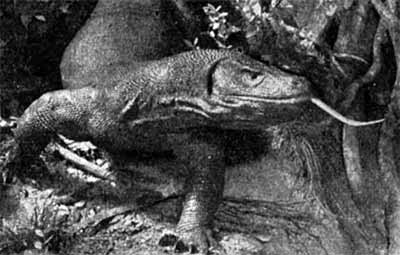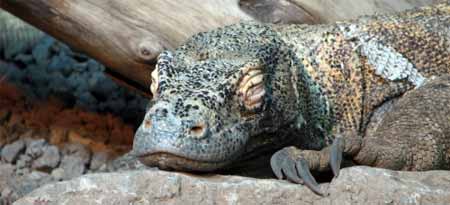
 Meat-eaters: Komodo dragons are carnivorous. Although they seem to like carrion, studies show that they also hunt live prey with a stealthy approach followed by a sudden short charge, during which they can run briefly at speeds up to 20 km/h (13 mph). Meat-eaters: Komodo dragons are carnivorous. Although they seem to like carrion, studies show that they also hunt live prey with a stealthy approach followed by a sudden short charge, during which they can run briefly at speeds up to 20 km/h (13 mph).
Lethal Bite: Komodo dragons have not traditionally been considered venomous, but the serrations along their teeth are
an ideal niche for over 50 strains of bacteria. If the initial bite does not kill the prey, and it escapes, the deadly infections caused by the bacteria living in the dragon's teeth kill the prey within
a week.
Then the Komodo dragon descends upon its victim, tracking by smell to feed upon its dead flesh. The dragon also has large claws that are used when they are younger to climb trees, but when they are older these are used mainly as weapons.
What's for Dinner? The Komodo dragon's prey is wide ranging, and includes wild pigs, goats, deer, and water buffaloes. In the wild they have also been observed to eat other smaller dragons. Occasionally they have been known to eat humans and human corpses. Over a dozen human deaths have been attributed to dragon bites in the last century, though there are reports of survivors of the resulting septicemia.


Birds and Bees: Mating occurs between May and August, with the eggs laid in September. The female lays her eggs in the ground or in tree hollows, lending them some protection. Clutches usually contain an average of 20 eggs, and have an incubation period of 7 months. However, after the hatchlings are born, they are generally defenseless and many do not survive. Young Komodo dragons generally spend their first few years living in trees where they have a greater chance of survival. Komodo dragons take around five years to mature, growing to 2 meters in length, and they can live for up to 30 years.

Venomous, Indeed: Recently, new research using DNA analysis and other techniques at the University of Melbourne has questioned conventional wisdom and suggests that Komodo dragons and many other lizards are indeed venomous (or have venom-producing genes) and properly belong to a "venom clade" called Toxicofera. This new research calls into question the traditional view of evolution of the Squamata, and the DNA evidence now appears to indicate that modern lizards and snakes share an evolutionary ancestry that dates back more than 200 million years. This information has therefore caused many biologists to question the current classification of species in the order Squamata.
First Sightings: Sightings of the Komodo dragon were first reported to Europeans in 1910. Widespread knowledge came after 1912, in which Peter Ouwens, the director of the Zoological Museum at Bogor, Java, published a paper on the topic. In 1980 the Komodo National Park was founded to help protect their population.

All text is available under the terms
of the GNU Free Documentation License
|